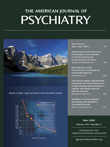In This Issue
Does Olanzapine Delay Psychosis?
Recognition that the first schizophrenia diagnosis is often preceded by prodromal symptoms has led to efforts to prevent the full-blown illness. The Prevention Through Risk Identification, Management, and Education (PRIME) study points to a possible role for olanzapine. People with prodromal symptoms of psychosis received either olanzapine or placebo for 1 year. McGlashan et al. (p. Original article: 790 ) report that olanzapine significantly improved positive symptoms, e.g., hallucinations. The rate of conversion to full psychosis was 38% for the patients taking placebo and 16% for those taking olanzapine (see figure above ). In the year after treatment stopped, the patients who had taken olanzapine experienced increasing symptoms and one-third became psychotic, further suggesting that olanzapine may help delay, but not prevent, psychosis in those at high risk.

Reducing Suicide Attempts in First-Episode Psychosis
The high risk of suicide is one of the dangers of unidentified psychosis. Lowering that risk was one of the positive outcomes of a program in Norway for early detection of psychosis, according to Melle et al. (p. Original article: 800 ). Of four equivalent health care areas, two were exposed to repeated information campaigns directed at the general population and health care personnel and were assigned easily accessible clinical teams capable of rapid assessment and triage. Of the 140 patients in these areas who were diagnosed with a first-episode psychotic disorder over 4 years, 4% reported recent suicidal plans or attempts, versus 17% for patients in the two areas without the intervention. An editorial discussing suicide reduction by Jill M. Harkavy-Friedman is on p. Original article: 768 .
Light Therapy and Fluoxetine Are Equal for Seasonal Mood Disorder
In a head-to-head comparison, bright light and the antidepressant fluoxetine were equally effective for treating seasonal affective disorder. Each treatment was known to work better than placebo, but a large, extended Canadian study by Lam et al. (p. Original article: 805 and featured on the cover) now establishes that the two are equivalent to each other. Over 8 weeks, clinical remission occurred in 50% and 54% of the patients who received light therapy and fluoxetine, respectively, for the winter form of seasonal affective disorder. Light therapy worked for patients even with particularly severe symptoms, and it produced a greater response at 1 week. Agitation, sleep disturbance, and palpitations were less common in patients receiving light therapy, but the total number of side effects did not differ. How light effects the brain is discussed in the Images in Neuroscience on p. Original article: 771 .
Sertraline Improves Night Eating Syndrome
Night eating syndrome may reflect delayed circadian timing of food intake: lack of appetite in the morning, overeating in the evening, and nighttime awakenings for eating. A placebo-controlled study by O’Reardon et al. (p. Original article: 893 ) demonstrated a striking response of night eating syndrome to the antidepressant sertraline, a selective serotonin reuptake inhibitor. The improvement followed 17.6 years of illness on average and was not related to depressive symptoms. Nocturnal ingestions fell by about 80% in the sertraline patients (see figure above ), who lost an average of more than 6 pounds. A possible mechanism of this response is suggested by the projections of serotonergic neurons into the suprachiasmatic nucleus of the hypothalamus, where circadian rhythms are maintained.




